The Truncated Cube
The truncated cube is a 3D uniform polyhedron bounded by 14 polygons (8 triangles and 6 octagons), 36 edges, and 24 vertices. It may be constructed by truncating the cube's vertices at (2-√2) of its edge length. More simply, it may be constructed by radially expanding the cube's edges outwards by 1/√2 of its edge length and taking the convex hull. It may also be constructed by radially expanding the triangular faces of the cuboctahedron outwards.
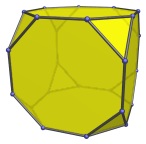
The truncated cube can be augmented with a square cupola (J4) to produce an augmented truncated cube (J66), one of the Johnson solids. Adding a second square cupola on the opposite side produces the biaugmented truncated cube (J67).
The dual of the truncated cube is the triakis octahedron, a Catalan solid.
Projections
In order to be able to identify the truncated cube in various projections of 4D objects, it is useful to know how it appears from various viewpoints. The following are some of the commonly-encountered views:
| Projection | Envelope | Description |
|---|---|---|
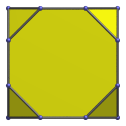 |
Square | Parallel projection centered on an octagonal face. |
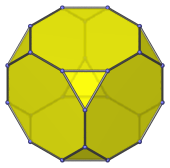 |
Regular dodecagon | Parallel projection centered on a triangular face. |
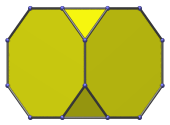 |
Octagon | Parallel projection centered on an edge shared between two octagons. |
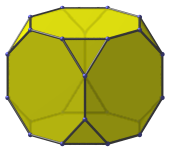 |
Dodecagon | Vertex-centered parallel projection. |
Coordinates
The Cartesian coordinates of the truncated cube, centered on the origin and having edge length 2, are all permutations of coordinates and changes of sign of:
- (1, (1+√2), (1+√2))
Occurrences
The truncated cube occurs as cells in the following uniform polychora:
- The truncated tesseract, its direct 4D analogue;
- The runcitruncated tesseract;
- The bitruncated 24-cell, whose surface consists entirely of truncated cubes;
- The cantitruncated 24-cell.
It also occurs in the following CRF polychora (amongst others):




